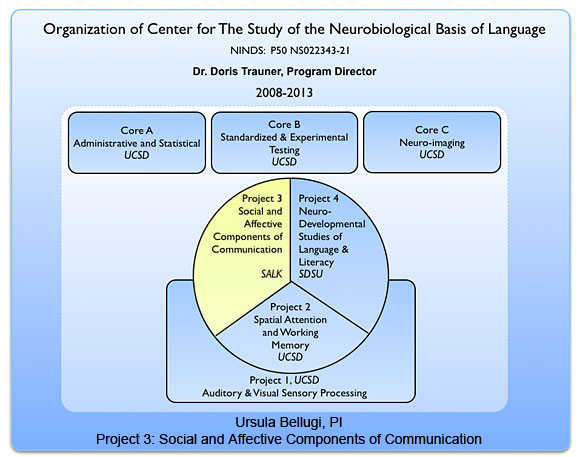Project 3: Social and Affective Components of Communication [NS022343-21], Ursula Bellugi,PI
The Development of Language and Cognitive Functions in Genetically Based Disorders
This project is one of five united under the Project in Cognitive and Neural development (PCND), a multi-centered project housed at the University of California at San Diego. The purpose of this multidisciplinary Center is to explore the neural bases of language and cognitive development from 7-18 years of age, combining cross-sectional and longitudinal neurocognitive research with neural imaging (event-related brain potentials (ERP); functional magnetic resonance imaging (fMRI)) to study normal and abnormal brain development, and the alternative forms of brain organization that can emerge under pathological conditions. Our specific focus in this laboratory is to examine language and cognitive development in children (infants to 12 years of age) with Williams syndrome (WS) and Down syndrome (DS). Other projects in the PCND are studying children with Language Impairment, pre- or perinatally acquired focal lesions, and children with later onset cerebral lesions. All projects combine their data to ultimately identify the neural basis of language and cognitive development.
Our ongoing studies include:
Contrasting the development of Language and General Cognition in WS. Importantly, in the development of first words, WS and DS children are equally delayed, and it is only as grammar emerges that WS children appear to show an increasing advantage over their DS peers. We are investigating both on-line and off-line measures focusing on associations and dissociations between language and other cognitive domains, as well as the development of discourse functions to obtain a greater understanding of the role genetics and neural development play in language acquisition. We are further studying the functional role language plays within these syndromes. For example, we have found increased emotional and social expressivity in the language of WS children but not other Center populations, which may be related to their strong social drive. Also, because of their severe spatial cognitive deficit, WS children provide a special opportunity to probe potential dissociations between language and spatial representations.
The Dissociation between Space and Face Processing in WS. WS results in a highly specific impairment in spatial construction. In contrast, face processing, another type of visual processing, is a relative strength. Thus, WS children provide a powerful vehicle for investigating the developmental separability of functions within the visual domain.
Brain Organization in the Developing Child with WS. We are also examining the hypothesis that developmental aspects of language and spatial functions in WS may be mediated by neural systems that differ in major ways from those in normal populations. In particular, evidence suggests that there may be differential dysfunction in the dorsal as opposed to the ventral stream of visual processing in WS. These studies employ cognitive, ERP, and fMRI technologies. Comparison of the profiles of developing WS children and other Center populations provides insights into issues of the genetic bases of higher cortical functions.






